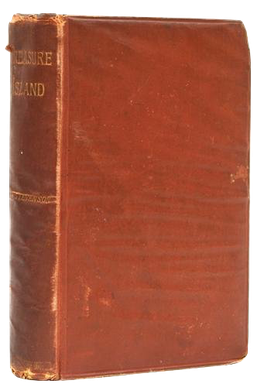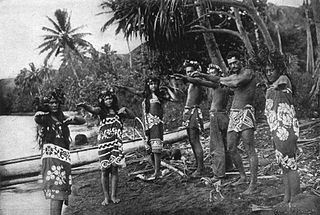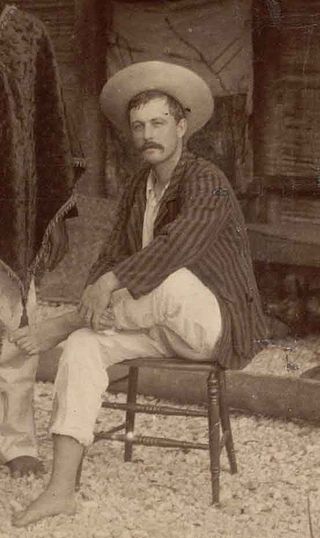
Robert Louis Stevenson was a Scottish novelist, essayist, poet and travel writer. He is best known for works such as Treasure Island, Strange Case of Dr Jekyll and Mr Hyde, Kidnapped and A Child's Garden of Verses.

George Woodcock was a Canadian writer of political biography and history, an anarchist thinker, a philosopher, an essayist and literary critic. He was also a poet and published several volumes of travel writing. In 1959 he was the founding editor of the journal Canadian Literature which was the first academic journal specifically dedicated to Canadian writing. He is most commonly known outside Canada for his book Anarchism: A History of Libertarian Ideas and Movements (1962).

Treasure Island is an adventure novel by Scottish author Robert Louis Stevenson, telling a story of "buccaneers and buried gold". It is considered a coming-of-age story and is noted for its atmosphere, characters, and action.

Long John Silver is a fictional character and the main antagonist in the novel Treasure Island (1883) by Robert Louis Stevenson. The most colourful and complex character in the book, he continues to appear in popular culture. His missing leg and parrot, in particular, have greatly contributed to the image of the pirate in popular culture.

Pamela Stephenson, Lady Connolly is a New Zealand-born psychologist, writer, actress and comedian. She moved with her family to Australia in 1953 and studied at the National Institute of Dramatic Art (NIDA). After playing several stage and television roles, she emigrated to the United Kingdom in 1976.
"The Skye Boat Song" is a late 19th-century Scottish song adaptation of a Gaelic song composed c.1782 by William Ross, entitled Cuachag nan Craobh. In the original song, the composer laments to a cuckoo that his unrequited love, Lady Marion Ross, is rejecting him. The 19th century English lyrics instead evoked the journey of Prince Charles Edward Stuart from Benbecula to the Isle of Skye as he evaded capture by government soldiers after his defeat at the Battle of Culloden in 1746.

The Marquesas Islands were colonized by seafaring Polynesians as early as 300 AD, thought to originate from Tonga and the Samoan Islands. The dense population was concentrated in the narrow valleys and consisted of warring tribes.
Leon Garfield FRSL was a British writer of fiction. He is best known for children's historical novels, though he also wrote for adults. He wrote more than thirty books and scripted Shakespeare: The Animated Tales for television.

Captain J. Flint is a fictional golden age pirate captain who features in a number of novels, television series, and films. The original character was created by the Scottish writer Robert Louis Stevenson (1850–1894). Flint first appears in the classic adventure yarn Treasure Island, which was first serialised in a children's magazine in 1881, and later published as a novel in 1883.
"Dead Man's Chest" is a fictional sea song, originally from Robert Louis Stevenson's novel Treasure Island (1883). It was expanded in a poem, titled "Derelict" by Young E. Allison, published in the Louisville Courier-Journal in 1891. It has since been used in many later works of art in various forms.

Dubh Artach is a remote skerry of basalt rock off the west coast of Scotland lying 18 miles (29 km) west of Colonsay and 15 miles (24 km) south-west of the Ross of Mull.

Abemama (Apamama) is an atoll, one of the Gilberts group in Kiribati, and is located 152 kilometres southeast of Tarawa and just north of the Equator. Abemama has an area of 27.37 square kilometres and a population of 3,299 as of 2015. The islets surround a deep lagoon. The eastern part of the atoll of Abemama is linked together by causeways making automobile traffic possible between the different islets. The outlying islands of Abatiku and Biike are situated on the southwestern side of the atoll.

Samuel Lloyd Osbourne was an American author and the stepson of the Scottish author Robert Louis Stevenson, with whom he co-authored three books, including The Wrecker. He also provided input and ideas on others. Osbourne wrote a number of stories and essays on his own, including An Intimate Portrait of R L S By His Stepson (1924).

Frances Matilda Van de Grift Osbourne Stevenson was an American magazine writer. She became a supporter and later the wife of Robert Louis Stevenson, and the mother of Isobel Osbourne, Samuel Lloyd Osbourne, and Hervey Stewart Osbourne.

The Wrecker (1892) is an ocean adventure novel written by Robert Louis Stevenson in collaboration with his stepson Lloyd Osbourne that was used sixty-five years later as the basis for an episode of the television series Maverick (1957) starring James Garner and Jack Kelly.

In English-speaking popular culture, the modern pirate stereotype owes its attributes mostly to the imagined tradition of the 18th-century Caribbean pirate sailing off the Spanish Main and to such celebrated 20th-century depictions as Captain Hook and his crew in the theatrical and film versions of J. M. Barrie's children's book Peter Pan, Robert Newton's portrayal of Long John Silver in the 1950 film adaptation of the Robert Louis Stevenson novel Treasure Island, and various adaptations of the Middle Eastern pirate, Sinbad the Sailor. In these and countless other books, films, and legends, pirates are portrayed as "swashbucklers" and "plunderers". They are shown on ships, often wearing eyepatches or peg legs, having a parrot perched on their shoulder, speaking in a West Country accent, and saying phrases like "Arr, matey" and "Avast, me hearty". Pirates have retained their image through pirate-themed tourist attractions, film, toys, books and plays.

Island Nights' Entertainments is a collection of short stories by Robert Louis Stevenson, first published in 1893. It would prove to contain some of his final completed work before his death in 1894.

Francis James Joseph Raphael Delaney was an Irish novelist, journalist and broadcaster. He was the author of The New York Times best-seller Ireland, the non-fiction book Simple Courage: A True Story of Peril on the Sea and many other works of fiction, non-fiction and collections. He was born in Thomastown, Tipperary, Ireland.

Mount Vaea is a 472 m summit overlooking Apia, the capital of Samoa located on the north central coast of Upolu island. The mountain is situated south about 3 km inland from Apia township and harbour. The settlement at the foothills on the northern side of the mountain is called Lalovaea.

John Wilberforce "Jack" Buckland (1864–1897), also known as "Tin Jack", was a trader who lived in the South Pacific in the late 19th century. He travelled with Robert Louis Stevenson and his stories of life as an island trader became the inspiration for the character of Tommy Hadden in The Wrecker (1892).
















